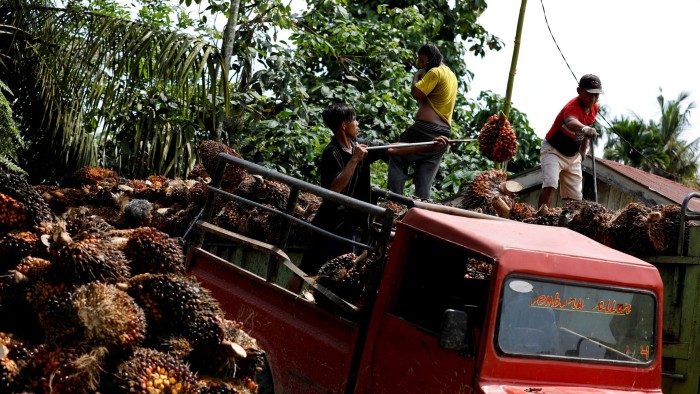Traders are bracing for a glut of Indonesian palm oil after a clampdown on illicit exports by the world’s largest producer squeezes demand from European energy and transport suppliers.
The commodity is widely used in everything from chocolate bars to shampoo and biofuels but has come under increasing scrutiny from governments concerned its production requires large tracts of rainforest to be destroyed.
Palm oil traded on the Bursa Malaysia Derivatives exchange, the global benchmark, fell from a 30-month high of more than RM5,150 ($1,167) per tonne in December to less than RM4,200 ringgit in January after Indonesia curbed exports on used cooking oil and palm oil waste products.
That has raised fears of a glut of virgin palm oil, as many Indonesian producers had offloaded excess supplies to companies in Europe looking for biofuel.
The ban is having “an implication on price because now what you see all of a sudden, there’s a lot of palm oil available in the country”, said Mohd Haris Mohd Arshad, chief operating officer at SD Guthrie, a Malaysian palm oil producer previously known as Sime Darby Plantation.
“Palm oil was being blended into whatever used cooking oil that they could collect,” he said. “Typically, they would be exporting it to traders, who would then bring it over to Europe.”
Indonesia’s ban has added further strain to a market already still adjusting to the fallout from an EU push four years ago to stop companies that consumed vast amounts of biofuel from using palm oil sourced from deforested land.
Companies across industries — from oil companies such as Shell and BP to automotive manufacturers such as Ford and Volkswagen, as well as airlines including Lufthansa — use biofuels to power trucks and planes.
To suppress demand the bloc offered incentives to large consumers to buy used cooking oils rather than virgin palm oil from deforested land.
However, industry insiders said some Asian exporters relabelled virgin palm oil labelled as used cooking oil, or blended used oil with fresh supplies, creating a more opaque market.
A study from campaign group Transport & Environment published last June showed that China and Malaysia were exporting more used cooking oil to Europe than was theoretically available. Malaysia alone was exporting three times more used cooking oil than was collected in the country, according to data cited by the study.

Indonesia’s trade ministry estimated that exports of palm oil residue and used cooking oil, two of the main byproducts from production, increased by 21 per cent between 2019 and 2023. Exports of crude palm oil fell by a fifth in the same period, the government found.
The two trends showed that used cooking oil and palm oil residue exports “were not purely from residue or used crude palm oil processing, but were also a mixture of virgin palm oil”, said the country’s trade minister Budi Santoso, when the ban came in at the start of the year.
“Overseas demand for waste feedstocks [such as used cooking oil] has soared in recent years due to environmental and sustainability requirements in certain importing countries,” it found.
Palm oil prices have rebounded in recent weeks, to RM4,700 per tonne, after the world’s second-largest producer, Malaysia, said production this year would be affected by heavy rainfall in south-east Asia.
Indonesia has said it plans to use the surplus to bolster demand in the local market and mandated that biofuels must be blended with 40 per cent palm oil, up from 35 per cent.
Oscar Tjakra of Rabobank said he expected the mandate would help prices after January’s “correction” to stabilise and rise, and be further supported by limited year-on-year production in Indonesia and Malaysia.
He predicted that there would be a deficit of global palm oil in the year to October, the timeframe the industry regards as its annual cycle for growing, harvesting and distributing palm oil.
However, SD Guthrie’s Arshad said it was unlikely that Indonesian consumers would accept the higher prices of palm oil-enriched biofuel in comparison to regular diesel. Nor would the government be able to fund the required subsidies, he said.
And producers worry that the global market for palm oil may face further pressures that could push prices further lower.
The US was due to introduce a Biden-era tax incentive this year to encourage production of clean fuels for transportation. The incentive intended to offer tax credits to companies that produced low-carbon fuels, including palm oil waste products that can be turned into biofuels.
However, the Trump administration has postponed the plan and is consulting the market on potential changes, including excluding used cooking oil from the scope of the incentive scheme.
Exclusion could force US refiners to seek alternatives, extend the palm oil surplus and weigh on prices, said a Singapore-based biofuels executive who declined to be identified.
And while the market is adjusting, the EU is planning to further tighten its standards on the sourcing of palm oil at the end of the year. From January, companies will have to prove that the palm oil they import into Europe for use in all goods — from food to detergents and make-up — is not grown on deforested land.
Producers say it will be expensive to supply palm oil that is compliant with the bloc’s new rules.
“The cost of bringing palm oil into Europe will go up significantly because it will force producers to realign themselves and make sure they divert whatever [EU]-compliant oil they have into Europe,” he said.
Consumers would foot the bill, paying more for “everything”, he said: “toothpaste, chocolate . . . Greggs sausage rolls”.
https://www.ft.com/content/6e545a85-6c69-4e02-8775-eba5c19c9f36


